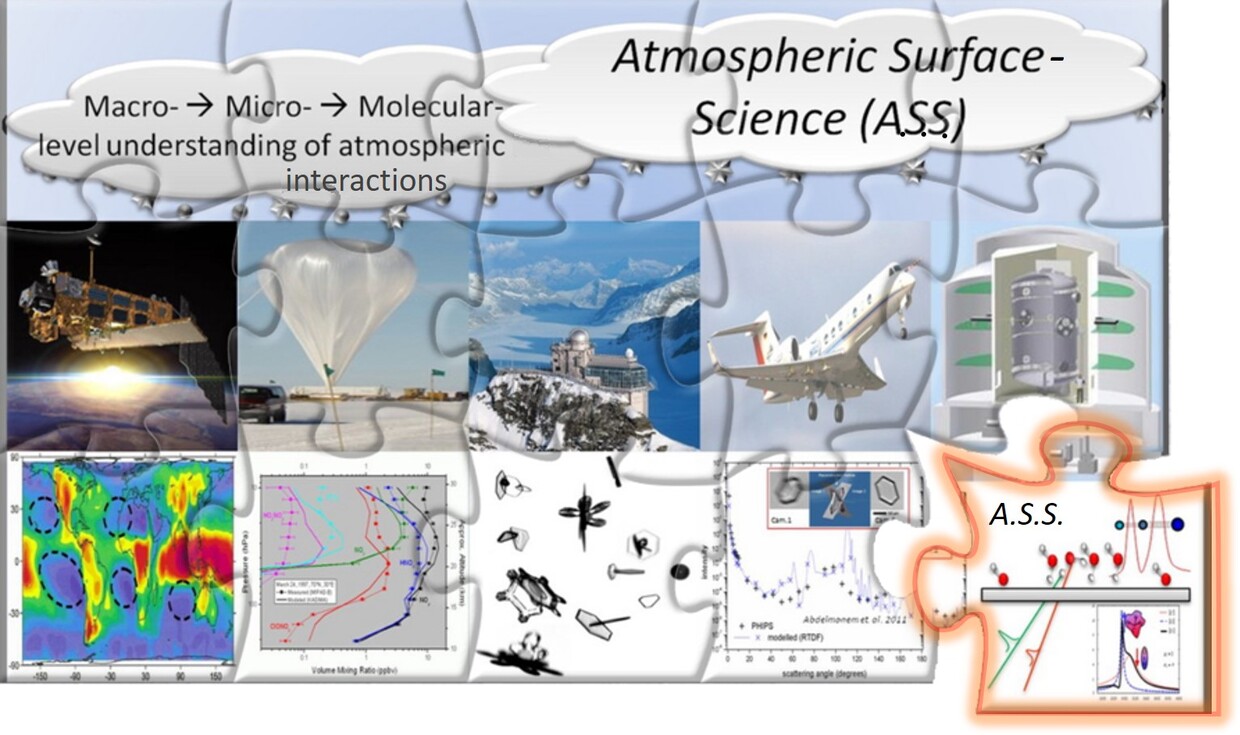Atmospheric Surface-Science (A.S.S.)

Introduction
Atmospheric aerosol-cloud-climate interactions are essential processes that include heterogeneous nucleation, particle oxidation, photosensitization, and the emission of volatile organic compounds (VOCs). These processes significantly impact cloud dynamics, precipitation formation, and ultimately climate change. Despite their importance, the molecular mechanisms and the contributions of different structural and chemical surface properties of atmospheric aerosols and ice nuclei controlling these processes remain largely unknown. To enhance our comprehension of atmospheric aerosol-water interactions, there is a growing demand for molecular-level probes. Second-harmonic and sum-frequency generation (SHG, SFG) nonlinear optical spectroscopy are potent techniques that are interface-selective and monolayer-sensitive, capable of exploring surface interactions on a molecular level. The KIT has recently obtained four successful grants (STUB 2012, AB 604/1-1, AB 604/1-2, and AB 604/3-1), enabling such studies. The primary objective of this research is to investigate atmospheric interactions on a molecular level.
Objectives
The primary scientific objective is to obtain a comprehensive understanding of aerosol-water and ice interactions within the atmosphere. One aspect of this research aims to distinguish the molecular properties of water and ice during heterogeneous ice nucleation and determine the parameters that impact this process. Additionally, this research aims to enhance our comprehension of the effect of bulk water properties on photochemistry at water body surfaces, which affects the emission of volatile organic compounds (VOCs) and the nucleation and growth of secondary organic aerosols (SOAs).
Research and methodology
Conventional techniques such as Fourier Transform Infrared (FTIR) and light absorption spectroscopy do not accurately account for the contribution of surface molecules due to their minute detectable signal. However, second-order nonlinear optical techniques such as SHG and SFG can overcome this limitation. SHG and SFG are highly sensitive optical probes that effectively analyze surfaces and interfaces. In this research, the IMK-AAF utilizes a femtosecond laser system (Solstice, 800nm, 3.5mJ, 80fs), TPR-TOPAS-F, and TPR-NDFG1-F. To study heterogeneous ice nucleation and photochemistry, a supercooled SHG/SFG setup, precise temperature-controlled cold-stage, and a homemade environmental cell and irradiation source are employed.
Important events:
- EGU General Assembly: AS3.16 - Atmospheric surface science and ice nucleating particles (link)
- The 19th European Conference On Non-Linear Optical Spectroscopy (ECONOS 2020/2021) is organized in 2021 by the A.S.S. @ KIT (Proceedings: https://doi.org/10.5445/IR/1000139469)

Contact:
Funded by the German Research Foundation (DFG)
-------------------------------------------
Related publications:
- Abdelmonem, A., Zhang, Y., Braunschweig, B., Glikman, D., Rumpel, A., Peukert, W., Begović, T., Liu, X., and Lützenkirchen, J.: Adsorption of CTAB on Sapphire-c at High pH: Surface and Zeta Potential Measurements Combined with Sum-Frequency and Second-Harmonic Generation, Langmuir, 38, 3380-3391, doi: 10.1021/acs.langmuir.1c03069, 2022.
- Abdelmonem, A., Morelová, N., Finck, N., Schild, D., and Lützenkirchen, J.: Unexpected behavior of sodium sulfate observed in experimental freezing and corrosion studies, Journal of Raman Spectroscopy, 52, 1499-1506, doi: https://doi.org/10.1002/jrs.6200, 2021.
- Abdelmonem, A.; Ratnayake, S.; Toner, J. D.; Lützenkirchen, J. Cloud history can change water–ice–surface interactions of oxide mineral aerosols: a case study on silica. Atmos. Chem. Phys. 2020, 20, 1075-1087. DOI: 10.5194/acp-20-1075-2020.
- Abdelmonem, A.; Wang, Y.; Lützenkirchen, J.; Alves, M., Calcium Uptake on Kaolinite and Gibbsite: Effects of Sulfate, pH, and Salt Concentration with Additional Insight from Second Harmonic Generation on Temperature Dependencies with Sapphire-Basal Planes and the Potential Relevance to Ice Nucleation, in Advanced Sorption Process Applications, S. Edebali, Editor. 2018, InTech. DOI: 10.5772/intechopen.81273.
- Abdelmonem, A.; Backus, E. H. G.; Bonn, M. Ice Nucleation at the Water-Sapphire Interface: Transient Sum Frequency Response without Evidence for Transient Ice Phase. The Journal of Physical Chemistry C 2018, DOI: 10.1021/acs.jpcc.8b07480.
- Abdelmonem, A.; Wang, Y.; Lützenkirchen, J.; Alves, M. E., Calcium uptake on kaolinite, gibbsite: effects of sulfate, pH, and salt concentration with additional insight from second harmonic generation on temperature dependencies with sapphire basal planes and the potential relevance to ice nucleation. 2018, InTech (submitted, accepted, 2018).
- Lützenkirchen, J., Scharnweber, T., Ho, T.; Striolo, A., Sulpizi, M., and Abdelmonem, A.* A set-up for simultaneous measurement of second harmonic generation and streaming potential and some test applications. Journal of Colloid and Interface Science 2018, 529, 294-305. DOI: https://doi.org/10.1016/j.jcis.2018.06.017. (Free access until August 04, 2018 on ScienceDirect under: https://authors.elsevier.com/a/1XDtM4-sDJKjZ)
- Abdelmonem, A.: Direct molecular-level characterization of different heterogeneous freezing modes on mica – Part 1, Atmos. Chem. Phys., 17, 10733-10741, doi: 10.5194/acp-17-10733-2017, 2017.
- Abdelmonem, A., Backus, E. H. G., Hoffmann, N., Sánchez, M. A., Cyran, J. D., Kiselev, A., and Bonn, M.: Surface-charge-induced orientation of interfacial water suppresses heterogeneous ice nucleation on α-alumina (0001), Atmos. Chem. Phys., 17, 7827-7837, doi: 10.5194/acp-17-7827-2017, 2017.
- Preocanin, T., Abdelmonem, A., Montavon, G., and Luetzenkirchen, J.: Charging Behavior of Clays and Clay Minerals in Aqueous Electrolyte Solutions — Experimental Methods for Measuring the Charge and Interpreting the Results, in: Clays, Clay Minerals and Ceramic Materials Based on Clay Minerals, edited by: Nascimento, G. M. D., InTech, 51-88, 2016.
- Abdelmonem, A., Lützenkirchen, J., and Leisner, T.: Probing ice-nucleation processes on the molecular level using second harmonic generation spectroscopy, Atmos. Meas. Tech., 8, 3519-3526, doi: 10.5194/amt-8-3519-2015, 2015.
